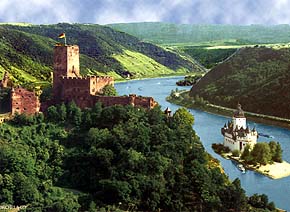
The Berlin Jewish Museum tells the entire story of German Jewry, from its origins in the Rhine Valley to the present. The museum's historical exhibit opens with a meter-cubed head of garlic with three cloves. Each of the cloves represents one of the original cities of the Jews of Ashkenaz, the Jewish center of ShUM which means garlic in Hebrew) - S[h]peyer, Worms and Mainz).
Mark admits to having the odd impression, or fantasy, easily checked and countered by looking at a map, that the cities of Shum were on the east side of the Rhine river, hugging a cliffside with a castle above each one, as in this photo. And, no, we neither took the photo, nor saw this castle:
Much of Jewish history is, sadly, the story of shifting centers of learning, and, as early as 900 CE, these three cities formed the core of what was to become Ashkenazi Jewry.
As rabbinic students and students of Jewish history, we had long known of the importance of these three cities. Now we were about to explore them.